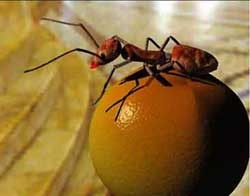 For the past 1,700 years, the Chinese have effectively combated harmful insects using purely biological methods: using one insect to eliminate another. Their most notable success is perhaps the use of the golden ant to protect citrus trees. In the “Southern Herbs Treatise” (On Plants in the South), written in 304 AD, there is a description of the use of golden ants as follows:
For the past 1,700 years, the Chinese have effectively combated harmful insects using purely biological methods: using one insect to eliminate another. Their most notable success is perhaps the use of the golden ant to protect citrus trees. In the “Southern Herbs Treatise” (On Plants in the South), written in 304 AD, there is a description of the use of golden ants as follows:
“The oranges are unusually sweet. The people of Giao Chỉ (the Vietnamese of that time) collect golden ants in dark clouds and bring them to the market for sale. The ant nests resemble cotton tufts. The nests are lined with small branches and sold along with the ants inside. These ants are a reddish-gold color and larger than regular ants. They do not eat oranges but attack and eliminate the insects that do. In the South, any citrus tree without these ants will be ravaged by various pests, leaving no fruit unspoiled.”
This biological approach to pest control first attracted Western attention through an article published in the “North China Herald” on April 4, 1882. However, it wasn’t until a severe rot epidemic devastated lemon and orange orchards in Florida in 1910 that the U.S. Department of Agriculture sent a botanist to China in 1915 to find a variety of orange resistant to rot, where he discovered the pest-eating ant species. In 1958, a Chinese scientist named Chen Shu Jian recommended further research on this ant species. To this day, in China, people continue to use ants to protect their oranges and tangerines.


















































